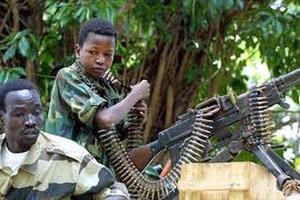African securityU.S. to intensify campaign against brutal Lord’s Resistance Army (LRA)
U.S. Special Forces continue to act on their commitment to capture Joseph Kony, leader of the Lord’s Resistance Army(LRA), a band of brutal rebels who have been kidnapping and killing villagers across central Africa for some years now. For the last two years, American military advisers have been assisting troops in four African nations — Uganda, South Sudan, Congo, and Central African Republic – in their war against the elusive LRA. Recently, the Pentagon has asked the White House for permission to expand the mission by using the Air Force’s CV-22 Osprey aircraft in Uganda, allowing troops to advance the assault on Kony.

A LRA child soldier ready ready for combat // Source: livedoor.jp
U.S. Special Forces continue to act on their commitment to capture Joseph Kony, leader of the Lord’s Resistance Army (LRA), a band of brutal rebels who have been kidnapping and killing villagers across central Africa for some years now. The LRA was formed to fight the Uganda People’s Defense Force (UPDF), the armed forces of Uganda. The Washington Post reports that for the last two years, American military advisers have been assisting troops in four African nations — Uganda, South Sudan, Congo, and Central African Republic – in their war against the elusive LRA. Recently, the Pentagon has asked the White House for permission to expand the mission by using the Air Force’s CV-22 Osprey aircraft in Uganda, allowing troops to advance the assault on Kony. In addition to the Osprey, which can land and take off like a helicopters and fly like a plane, the United States would nearly double the number of American troops in Uganda.
“We’re at a new stage in this mission,” said Col. Kevin Leahy, who commands the 100 Special Operations troops pursuing the LRA. “All of the pieces are coming together, and we’re pushing on all fronts.”
LRA fighters, some of whom were conscripted as children, are divided among several semi-autonomous cells spread across an area the size of Texas. They remain peripatetic, bedding down in camps nestled deep in the jungle, under foliage that shields them from cameras on American drones and satellites. “They eschew two-way radios — their signals can be tracked — and attacks on villages large enough to quickly summon help,” according to the Post. “This isn’t searching for a needle in a haystack,” Leahy said. “It’s like searching for a needle in 20 haystacks.”
The Obama administration has prohibited American troops from pursuing unilateral missions against the LRA. The administration also limited the role of American troops to training and advising African forces. Even in battle, American troops are permitted to shoot only in self-defence. The U.S. military’s role is focused on intelligence gathering and the planning and transportation of African troops to rebel grounds.
“Air Force Special Operations pilots haul supplies in planes intended to avoid a second glance — Polish-built twin-props painted to resemble civilian aircraft,” according to thePost.
Top U.S. commanders have regarded the strategy — facilitating local forces to lead the fight instead of American troops — as a model for addressing other rebel-caused instability around the
